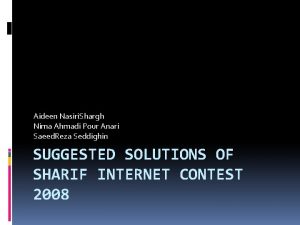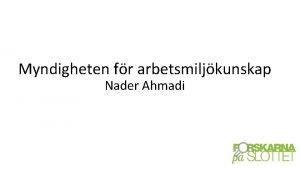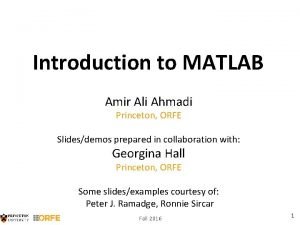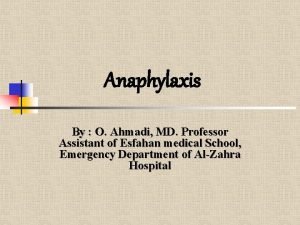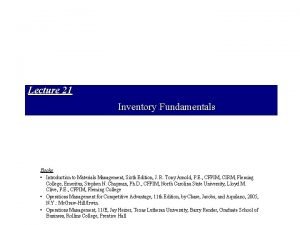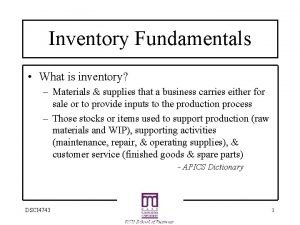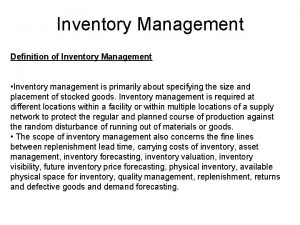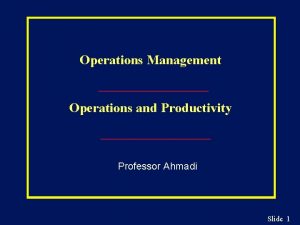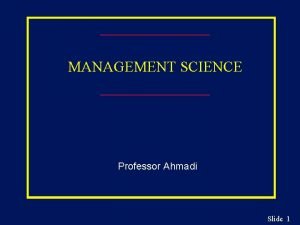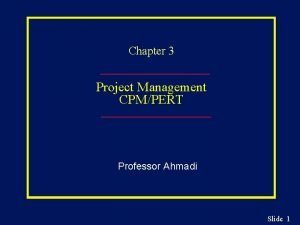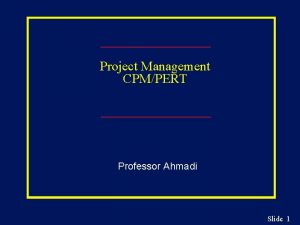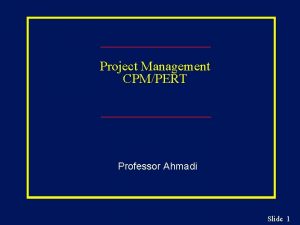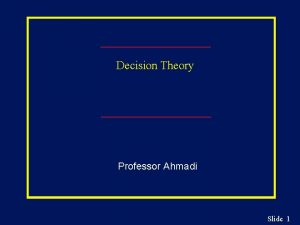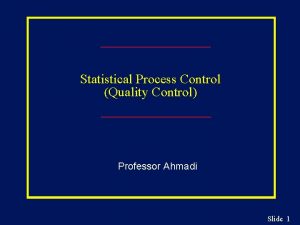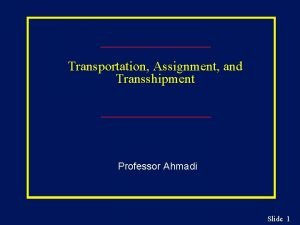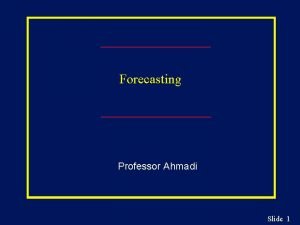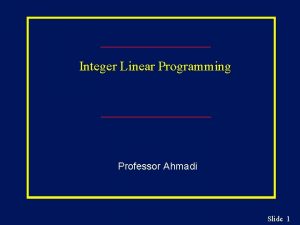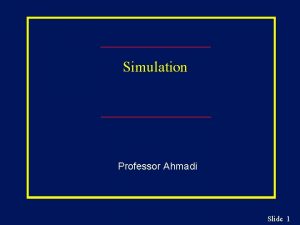Inventory Management Professor Ahmadi Slide 1 The Functions


















- Slides: 18

Inventory Management Professor Ahmadi Slide 1

The Functions of Inventory n n To ”decouple” or separate various parts of the production process To provide a stock of goods that will provide a “selection” for customers To take advantage of quantity discounts To hedge against inflation and upward price changes Slide 2

Types of Inventory n n Raw material Work-in-progress Maintenance/repair/operating supply Finished goods Slide 3

ABC Analysis n n n Divides on-hand inventory into 3 classes • A class, B class, C class Basis is usually annual $ volume • $ volume = Annual demand x Unit cost Policies based on ABC analysis • Develop class A suppliers more • Give tighter physical control of A items • Forecast A items more carefully Slide 4

Example of Classifying Items as ABC Class A B C % Annual $ Usage 100 80 60 % $ Vol 80 15 5 % Items 15 30 55 A 40 B 20 C 0 0 50 100 % of Inventory Items Slide 5

Cycle Counting n n Physically counting a sample of total inventory on a regular basis Used often with ABC classification • A items counted most often (e. g. , daily) Advantages of cycle counting • Eliminates shutdown and interruption of production necessary for annual physical inventories • Eliminates annual inventory adjustments • Allows the cause of errors to be identified and remedial action to be taken • Maintains accurate inventory records Slide 6

Independent versus Dependent Demand n Independent demand - demand for item is independent of demand for any other item n Dependent demand - demand for item is dependent upon the demand for some other item Slide 7

Inventory Costs n Holding costs - associated with holding or “carrying” inventory over time (Such as Obsolescence, Insurance, Extra staffing, Interest, Pilferage, Damage, Warehousing, Etc. ) n Ordering costs - associated with costs of placing order and receiving goods (Such as: Supplies, Forms, Order processing, Clerical support, Etc. ) n Setup costs - cost to prepare a machine or process for manufacturing an order (Such as Clean-up costs, Re-tooling costs, Adjustment costs, Etc. ) Slide 8

Inventory Models 3. Economic order quantity models (EOQ) Production order quantity models (POQ) Quantity discount 4. Probabilistic models (Normal Demand) 5. Probabilistic models (Discrete demand) 1. 2. Slide 9

EOQ Assumptions n n n Known and constant demand Known and constant lead time Instantaneous receipt of material No quantity discounts Only order (setup) cost and holding cost No stockouts Slide 10

Inventory Usage Over Time Inventory Level Order quantity = Q (maximum inventory level) Minimum inventory 0 Usage Rate Average Inventory (Q*/2) Time Slide 11

EOQ Model How Much to Order? Annual Cost ve r u t. C s Minimu m total cost Co l a t To d Hol v r u st C e in o C g Order (Setup) Cost Curve Optimal Order Quantity (Q*) Order quantity Slide 12

Deriving an EOQ 1. Develop an expression for setup or ordering costs 2. Develop an expression for holding cost 3. Set setup cost equal to holding cost 4. Solve the resulting equation for the best order quantity Slide 13

EOQ Model Equations 2 ×D× S H D Expected Number of Orders =N= Q* Optimal Order Quantity = Q* = Expected Time Between Orders = T = Working Days / Year N d= D Working Days / Year ROP = d × L D = Demand per year S = Setup (order) cost per order H = Holding (carrying) cost d = Demand per day L = Lead time in days Slide 14

Production Order Quantity Model (POQ) n n Answers how much to order and when to order Allows partial receipt of material • n Suited for production environment • • n Other EOQ assumptions apply Material produced, used immediately Provides production lot size Lower holding cost than EOQ model Slide 15

POQ Model Equations = Q* = Optimal Order Quantity p Maximum inventory level= Q* Setup Cost= D 2*D*S d H* 1 p ( ) 1 - d p * S Q ( ) Holding Cost= 0. 5 * H * Q 1 - d p D = Demand per year S = Setup cost H = Holding cost d = Demand per day p = Production per day Slide 16

Quantity Discount Model n n n Answers how much to order & when to order Allows quantity discounts • Reduced price when item is purchased in larger quantities • Other EOQ assumptions apply Trade-off is between lower price & increased holding cost Slide 17

Probabilistic Models n n Answers how much & when to order Allows demand to vary • • n Follows normal distribution Other EOQ assumptions apply Consider service level & safety stock • • Service level = 1 - Probability of stockout Higher service level means more safety stock • More safety stock means higher ROP Slide 18
 Heel and toe polka meaning
Heel and toe polka meaning Nima ahmadi pour anari
Nima ahmadi pour anari Nader ahmadi
Nader ahmadi Matlab princeton
Matlab princeton Nooria ahmadi
Nooria ahmadi Promotion from assistant to associate professor
Promotion from assistant to associate professor Functions of inventory
Functions of inventory Chapter 12 inventory management
Chapter 12 inventory management Factoring trinomials slide and divide method
Factoring trinomials slide and divide method Inventory fundamentals
Inventory fundamentals Inventory fundamentals
Inventory fundamentals Hát kết hợp bộ gõ cơ thể
Hát kết hợp bộ gõ cơ thể Slidetodoc
Slidetodoc Bổ thể
Bổ thể Tỉ lệ cơ thể trẻ em
Tỉ lệ cơ thể trẻ em Chó sói
Chó sói Tư thế worms-breton
Tư thế worms-breton Alleluia hat len nguoi oi
Alleluia hat len nguoi oi Các môn thể thao bắt đầu bằng tiếng nhảy
Các môn thể thao bắt đầu bằng tiếng nhảy

